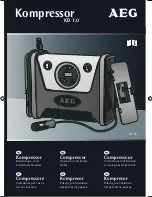
15
English
MAINTENANCE
Maintenance Chart
Procedure
Daily
W
eekly
Monthly
1 year
or 100
Hours
See tank
war
ning
label
Check safety valve
X
Inspect air filter
X+
Drain air tank
X
Check for unusual noise/vibration
X
Check for air leaks
X*
Clean compressor exterior
X
Remove tank from service
X++
* To check for air leaks apply a solution of soapy water around joints.
While compressor is pumping to pressure and after pressure cuts out,
look for air bubbles to form.
+ Perform more frequent in dusty or humid conditions.
++
For more information, call 1-888-895-4549 .
WARNING:
Risk of unsafe operation. Unit cycles automati-
cally when power is on. When performing maintenance, you
may be exposed to voltage sources, compressed air, or moving
parts. Personal injuries can occur. Before performing any main-
tenance or repair, disconnect power source from the compres-
sor and bleed off all air pressure.
To ensure efficient operation and longer life of the air compressor
outfit, a routine maintenance schedule should be prepared and fol-
lowed. The routine maintenance schedule (shown above) is geared
to an outfit in a normal working environment operating on a daily
basis. If necessary, the schedule should be modified to suit the con-
ditions under which your compressor is used. The modifications
will depend upon the hours of operation and the working environ-
ment. Compressor outfits in an extremely dirty and/or hostile envi-
ronment will require a greater frequency of all maintenance checks.
NOTE:
See
OPERATION
section for the location of controls.
Checking Safety Valve
WARNING:
Hot surfaces. Risk of burn. Tubes, pump head,
and surrounding parts are very hot, do not touch. Allow
compressor to cool prior to servicing.
WARNING:
Risk of bursting. If the safety valve does not
work properly, over-pressurization may occur, causing air tank
rupture or an explosion.
WARNING:
Risk from flying objects. Always wear certified
safety equipment: ANSI Z87.1 eye protection (CAN/CSA Z94.3)
with side shields.
Before starting compressor, pull the ring on the safety valve to
make sure that the safety valve operates freely. If the valve is
stuck or does not operate smoothly, it must be replaced with the
same type of valve.
Checking Air Filter
WARNING:
Hot surfaces. Risk of burn. Tubes, pump head, and
surrounding parts are very hot, do not touch. Allow compressor
to cool prior to servicing.
1. Ensure motor Auto/Off switch switch is in the
A
“Off (O)” position.
2. Allow unit to cool.
3. Remove filter (A).
















































